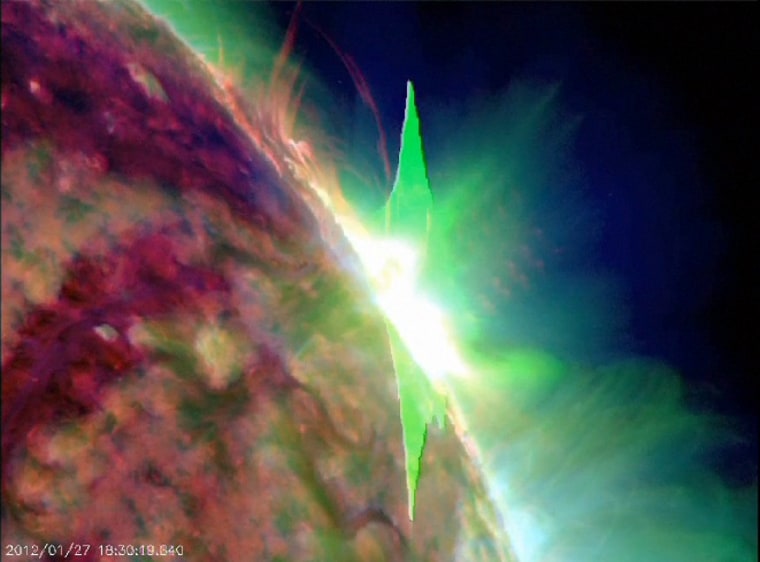
The sunspot responsible for setting off a colorful round of northern lights over the past week got off a doozy of a parting shot today, just as it was about to pass around the edge of the sun's disk.
Sunspot 1402 let loose with an X-class flare, the most powerful class of solar outburst, at 1:37 p.m. ET today, and NASA's Solar Dynamics Observatory captured a sequence of ultraviolet images as the blast went out. Fortunately, this one was not directed right at Earth.
SpaceWeather.com says NASA's Goddard Space Weather Laboratory detected a "spectacular" coronal mass ejection blasting away from the sun at 5.6 million mph (2,500 kilometers per second). CMEs send out electrically charged particles that can eventually interact with Earth's magnetic field — but here again, this particular ejection is not heading directly for Earth. There's a chance that it might strike a glancing blow on Monday or so, sparking another bout of auroral displays.
The National Oceanic and Atmospheric Administration's Space Weather Prediction Center reports that the flare created R3-level radio blackouts at about 1:30 p.m. ET today. That level can result in wide-area loss of high-frequency radio comunication, as well as a temporary degradation of low-frequency GPS signals, but no significant problems came to light immediately. Solar radiation levels are elevated — which may lead to the rerouting of some airline flights. NOAA's guide to space weather scales explains what's what.
Active regions move across the sun's disk from left to right, as seen from earth, so sunspot 1402 is just about to go around to the far side of the sun. There's a chance that the sunspot will come around again as the sun goes through its 27-day rotational cycle, and there are certain to be more (and stronger?) outbursts as the sun approaches the peak of its 11-year activity cycle in 2013 or so.
Keep a watch on SpaceWeather.com, NOAA's space weather website and the prediction center's Facebook page for updates during the weekend. And if you're living the high-latitude life, keep a watch for better-than-usual auroras as well.
Update for 4:05 p.m. ET: Sunday's solar storm not only blasted past Earth; it also sent solar particles streaming by NASA's Mars Science Laboratory, which is on its way to the Red Planet. Today, the Southwest Research Institute reported that one of the instruments on the spacecraft, the Radiation Assessment Detector, measured the effects of the solar storm.
"We only have a few hours of data downloaded from the RAD so far, but we clearly see the event," RAD principal investigator Don Hassler, science program director in SwRI's Space Studies Department, said in a news release. "It will be very interesting to compare the RAD data, collected from inside the capsule, with the data from other spacecraft."
Once Mars Science Laboratory gets to its destination, it will measure radiation levels on the Martian surface to determine what the effect might have been on past life ... as well as the radiation effects that astronauts can expect to experience during future interplanetary missions.
Update for 10:30 p.m. ET: In a Facebook update, the Space Weather Prediction Center says its "forecasters and scientist believe there will be very little effects of the CME observed here at Earth." The update also provides a killer video of the eruption, as seen in ultraviolet imagery from the Solar and Heliospheric Observatory. SpaceWeather.com, meanwhile, quotes experts at the Goddard Space Weather Lab as saying the CME "will just miss Earth when its edge passes by our planet on Jan. 30-31."
On tonight's "Nightly News," NBC's Brian Williams talked about a time-lapse video showing the aurora over Norway earlier this week. We included this video in Wednesday's northern lights roundup, but it's nice to hear Brian marvel over it again:
More auroral glories:
- Planet looks back at northern lights
- Auroras spark awe across the north
- Northern lights go way, way south
- Speed through Lapland's lights
- Beautiful blasts from solar storms
- Get a video view of Canada's aurora
- Slideshow: The best of the northern lights
- Cosmic Log's auroral archive
Alan Boyle is msnbc.com's science editor. Connect with the Cosmic Log community by "liking" the log's Facebook page, following @b0yle on Twitter or adding Cosmic Log's Google+ page to your circle. You can also check out "The Case for Pluto," my book about the controversial dwarf planet and the search for other worlds.